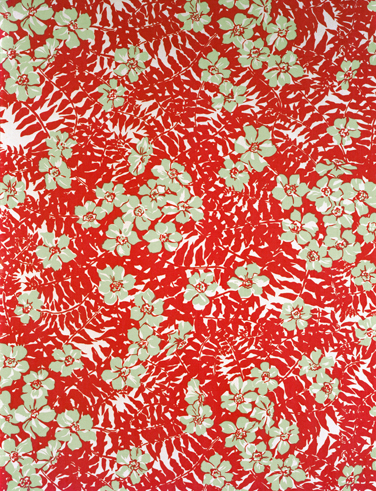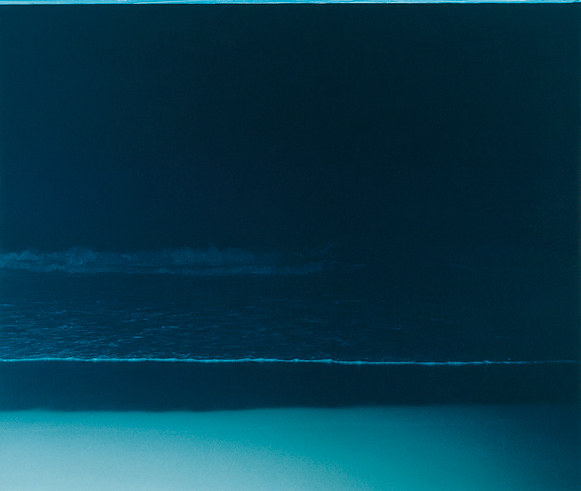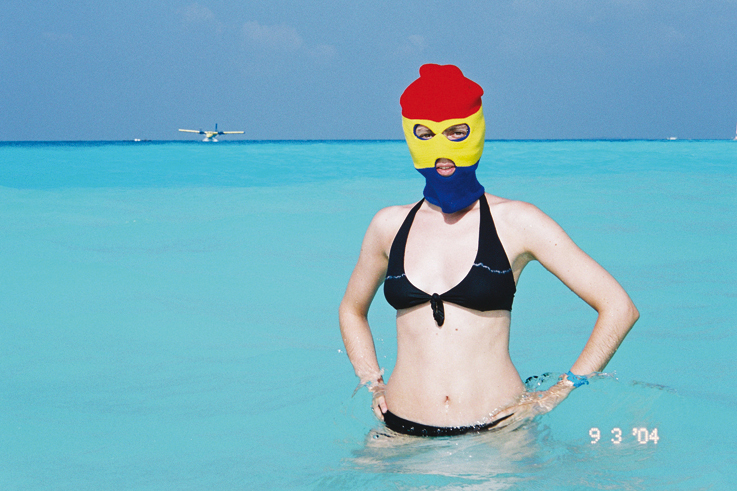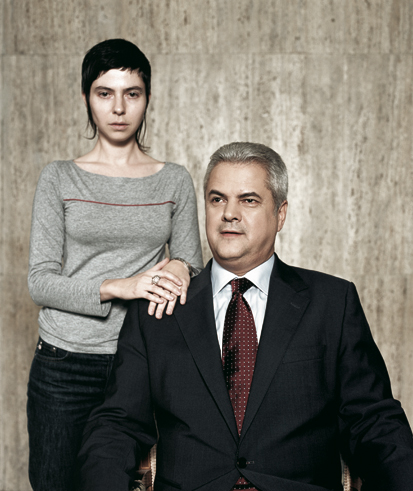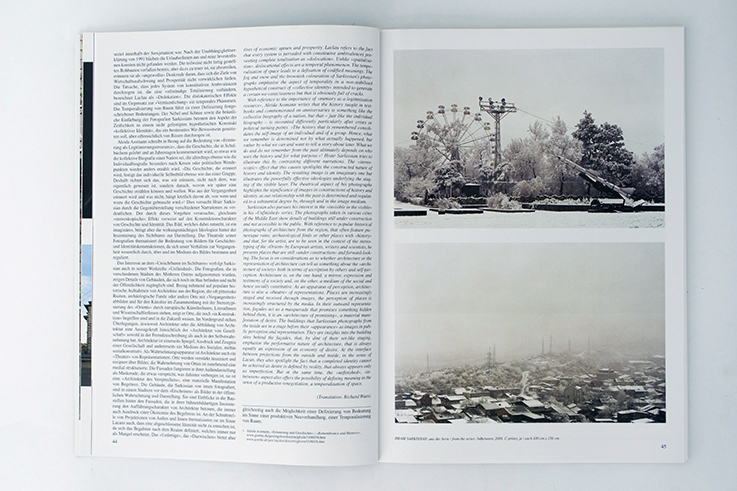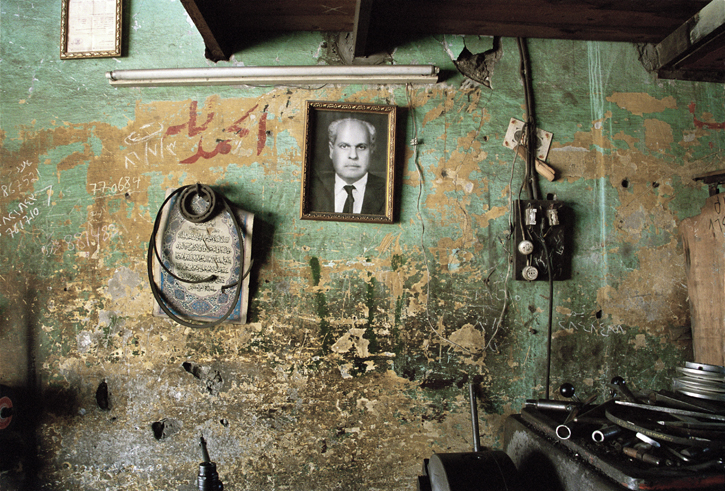Camera Austria International
102 | 2008
- JENS ASTHOFF
Annette Kelm - ANNETTE KELM
- ROLF SACHSSE
Iosif Király: Tinseltown Buzescu - IOSIF KIRÁLY
- COSMIN COSTINAS
Alexandra Croitoru: National Melodramas - ALEXANDRA CROITORU
- SØNKE GAU
Hrair Sarkissian: In-between Times and In-between Spaces - HRAIR SARKISSIAN
- CATHERINE DAVID
Taysir Batniji: Fathers - TAYSIR BATNIJI
- RAINER BELLENBAUM
Change of Dispositif IV
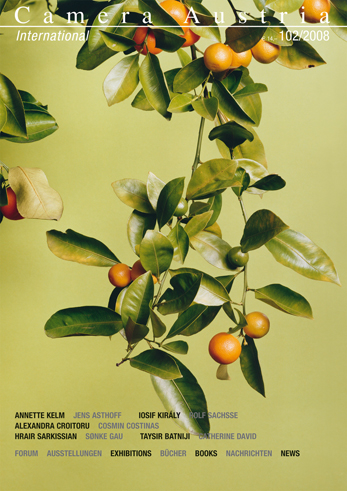
Preface
With his “Tinseltown Project” — a photographic study of the architecture and its (Roma) inhabitants in Buzescu, a street village south of Bucharest, that he developed over the course of several years — Iosif Király set out to depict the Roma-Romanian transition from tradition to socialism to postmodernism. In his text, Rolf Sachsse discusses Király’s deconstructivist method, whose work spotlights the fragile nature of the documentary approach: Where all style criteria threaten to fail, where all aesthetic criticism congeals into colonialism, photography becomes a strategy whose autonomy as art must be questioned only in a later process of observation. In another contribution dealing with contemporary Romanian art, Cosmin Costinas focuses on the work of artist Alexandra Croitoru, whose approach to “Romanian identity” is a blend of archaeological curiosity, sometimes driven by vestiges of the “transition mentality”, and advocacy of change and “Westernisation”, but always characterised by a critical, detached openness. In her photos she deals with the melodrama of constructing Romania’s self-image.
The works of Syrian artist Hrair Sarkissian also revolve around topics of individual and collective memory and identity. In this issue we present excerpts of his “Unfinished” series – pictures of building shells in various cities of the Middle East – and “InBetween” – socialist architectures and memorials in the context of the military conflict between Armenia and Azerbaijan. Sønke Gau interprets Sarkissian’s works against the foil of Ernesto Laclau and his theory of spatialisation as hegemonisation of time and cementation of meaning. In contrast to Sarkissian, the Palestinian artist Taysir Batniji refuses to simply depict the territorial and political situation of the Gaza Strip region in his “Pères” (fathers) project, and, with a collection of portraits of fathers, Arab leaders and martyrs, confronts it with “a fiction” that raises the question of conflicting perceptions of history. With the aid of the concept of fiction, as coined by Rancière, Catherine David works her way towards this »quieter, more subdued interplay of the tensions and oppositions at work under the noise of appearance«.
Read more →Camera Austria International 102 | 2008
Preface
With his “Tinseltown Project” — a photographic study of the architecture and its (Roma) inhabitants in Buzescu, a street village south of Bucharest, that he developed over the course of several years — Iosif Király set out to depict the Roma-Romanian transition from tradition to socialism to postmodernism. In his text, Rolf Sachsse discusses Király’s deconstructivist method, whose work spotlights the fragile nature of the documentary approach: Where all style criteria threaten to fail, where all aesthetic criticism congeals into colonialism, photography becomes a strategy whose autonomy as art must be questioned only in a later process of observation. In another contribution dealing with contemporary Romanian art, Cosmin Costinas focuses on the work of artist Alexandra Croitoru, whose approach to “Romanian identity” is a blend of archaeological curiosity, sometimes driven by vestiges of the “transition mentality”, and advocacy of change and “Westernisation”, but always characterised by a critical, detached openness. In her photos she deals with the melodrama of constructing Romania’s self-image.
The works of Syrian artist Hrair Sarkissian also revolve around topics of individual and collective memory and identity. In this issue we present excerpts of his “Unfinished” series – pictures of building shells in various cities of the Middle East – and “InBetween” – socialist architectures and memorials in the context of the military conflict between Armenia and Azerbaijan. Sønke Gau interprets Sarkissian’s works against the foil of Ernesto Laclau and his theory of spatialisation as hegemonisation of time and cementation of meaning. In contrast to Sarkissian, the Palestinian artist Taysir Batniji refuses to simply depict the territorial and political situation of the Gaza Strip region in his “Pères” (fathers) project, and, with a collection of portraits of fathers, Arab leaders and martyrs, confronts it with “a fiction” that raises the question of conflicting perceptions of history. With the aid of the concept of fiction, as coined by Rancière, Catherine David works her way towards this »quieter, more subdued interplay of the tensions and oppositions at work under the noise of appearance«.
While the works of the artists from Romania and the Middle East that we are presenting in this issue are based explicitly on pictorial conceptions that tie in closely with the political history/stories of their respective countries of origin, the work of German artist Annette Kelm focuses on an examination of various paradigms of photography. In her work, that she develops very autonomously, Kelm combines different styles and genres, often developing pictorial themes reminiscent of still lifes and portraits, object, architectural and landscape photography, at times also making reference to the visual languages of advertising. By exploring representational forms of photography, Kelm also shifts their co-ordinates and always negotiates the ambivalence of her pictures as a question of seeing, not of knowing, as Jens Asthoff elaborates in his accompanying essay.
Particularly in times when the art market is booming, it is important to us to focus our reflection on the different social uses of photography and to keep bringing the discussion back to the different paradigms of the photographic sphere. This is one reason for drawing your attention to our current exhibitions: The first retrospective of Hans van der Meer (with a selection of his photographs of minor league football clubs) is on show at Camera Austria / Kunsthaus Graz until 31/8, and “I am not afraid. The Market Photo Workshop, Johannesburg” – the exhibition accompanying Camera Austria No. 100 – is featuring at the Langhans Galerie in Prague (until 18/8/2008). We invite you to visit these exhibitions, but also to come and see us at our fair booths at the upcoming Photokina Köln, at Art Forum Berlin, at Paris Photo, and at Art Basel Miami Beach.
Christine Frisinghelli
Maren Lübbke-Tidow
June 2008
Entries
Forum
JAN STRADTMANN
CHRISTOPH BALZAR
JULIA GRÖNING
PAUL HYNES-ALLEN
STAFFORD SMITH
THOMAS HUMERY
MICHAEL GOLDGRUBER
YAEL SCHMIDT
MARKO ZINK
Exhibitions
Recovered Structures
Whitney Biennial 2008
Whitney Museum of American Art, New York
RACHEL BAUM
Exponential Future
Morris and Helen Belkin Art Gallery, University of British Columbia, Vancouver
CLINT BURNHAM
Art Sheffield 08: Yes, No, Other Options
Sheffield Contemporary Art Forum, Sheffield
BART VAN DER HEIDE
5th Berlin Biennial for Contemporary Art: When Things Cast No Shadows
KW Institute for Contemporary Art, Neue Nationalgalerie, Skulpturenpark Berlin_Zentrum, Schinkel Pavillon
DENISE ROBINSON
4. Triennale der Photographie
Hamburg
Sharon Lockhart
Kunstverein in Hamburg
Secession Wien
MAREN LÜBBKE-TIDOW
Thomas Demand: Camera
Kunsthalle, Hamburg
Peter Fischli, David Weiss: Fragen und Blumen. Eine Retrospektive
Deichtorhallen, Hamburg
KIRSTY BELL
Dem Elend auf den Popo klopfen
Heinrich Zille: Kinder der Straße
Akademie der Künste, Berlin
Lindenau-Museum, Altenburg
Städtische Galerie, Villingen-Schwenningen
ALICE CREISCHER UND ANDREAS SIEKMANN
Die Schweiz ist schön
Hans Finsler und die Schweizer Fotokultur
Museum für Gestaltung Zürich
Stiftung Moritzburg, Kunstmuseum des Landes Sachsen-Anhalt
FRIEDRICH TIETJEN
The Stamp of Fantasy
Fotomuseum Winterthur
Jeu de Paume, Paris
Museum Folkwang, Essen
STEVEN HUMBLET
Eija-Liisa Ahtila: A retrospective
Jeu de Paume, Paris
K21, Düsseldorf
MAUREEN TURIM
Markus Schinwald
Augarten Contemporary, Wien
Migros Museum für Gegenwartskunst, Zürich
WALTER SEIDL
The Body is a Vessel of Time and Air
Miyako Ishiuchi: Photographs 1976 – 2005
Langhans Galerie, Prag
Foam, Amsterdam
Michael Hoppen Gallery, London
La Filature, Scène nationale, Mulhouse
SABINE SPILLES
Maria Hahnenkamp
Salzburger Kunstverein
ULRIKE MATZER
At Your Disposal
Michael Schuster: For Your Information
Neue Galerie am Landesmuseum Joanneum, Graz
REINHARD BRAUN
Derek Jarman curated by Isaac Julien
Serpentine Gallery, London
Kunsthalle, Wien
MARTIN HERBERT
Blur Life
Chris Marker: A Farewell to Movies
Museum für Gestaltung, Zürich
JOCHEN BECKER
Noh Suntag: Ausnahmezustand
Württembergischer Kunstverein
KATRIN MUNDT
Katastrophenalarm
Neue Gesellschaft für Bildende Kunst, Berlin
Tornado
General Public, Berlin
Ökomedien
Edith-Ruß-Haus für Medienkunst, Oldenburg
KRYSTIAN WOZNICKI
Books
Kai-Olaf Hesse: Topography of the Titanic
Belfast Exposed Photography, Belfast
ex pose Verlag, Berlin 2007
ROLF SACHSSE
Helen Levitt
powerHouse Books, Brooklyn 2008
Hatje Cantz, Ostfildern 2008
ANNE BERTRAND
It came from Memphis
Christian Patterson: Sound Affects
Kaune-Sudendorf, Köln 2008
KERSTIN STREMMEL
James Morrison: The cinema of Todd Haynes. All that heaven allows
Wallflower Press, London 2007
ANNETT BUSCH
James Benning
Synema – Gesellschaft für Film und Medien, Wien 2007
KATHRIN PETERS
Marina Grzinic: Re-politicizing Art, Theory, Representation and New Media Technology
Schlebrügge Verlag, Vienna, 2008
WALTER SEIDL
Critical Realism in Contemporary Art. Around Allan Sekula’s photography
Leuven University Press, Leuven 2006
SUSANNE HOLSCHBACH
Linda Hentschel: Bilderpolitik in Zeiten von Krieg und Terror. Medien, Macht und Geschlechterverhältnisse
b_books, Berlin 2008
SUSANNE HOLSCHBACH
Imprint
Publisher: Manfred Willmann. Owner: Verein CAMERA AUSTRIA, Labor für Fotografie und Theorie
All: Lendkai 1, A-8020 Graz
Editors Graz: Christine Frisinghelli, Sabine Spilles
Assistence: Eva Meran, Heidi Oswald
Editor Berlin: Maren Lübbke-Tidow
Copy editing: Marie Röbl
Translations: John Doherty, Don Mader, Wilfried Prantner, Richard Watts

